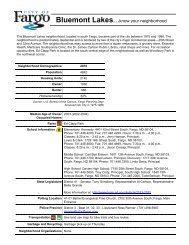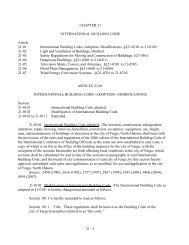You also want an ePaper? Increase the reach of your titles
YUMPU automatically turns print PDFs into web optimized ePapers that Google loves.
immediately any reagents that touch the skin. Store the equipment, properlyboxed or encased, in a clean, protected place. Do not interchange parts suchas solution tubes, bottle caps, or droppers.C. Be sure all reagents are fresh and that the same manufacturer who made thecolor samples has supplied them. Each manufacturer develops reagents,which are compatible with his/her own instruments, and not all reagents <strong>of</strong> thesame name are <strong>of</strong> equal composition or concentration. Reagents lose theirstrength on aging and exposure to light and should not be kept longer thanrecommended by the manufacturer.D. Avoid subjecting color standards and reagents to prolonged direct sunlight, ortemperatures over 100 degrees or below freezing.A-9 TESTING pHThe determination <strong>of</strong> pH is based on the ability <strong>of</strong> certain organic materials called indicatorsto change color with the change in acidity or alkalinity <strong>of</strong> the water. Addition <strong>of</strong> a smallamount <strong>of</strong> indicator to a sample <strong>of</strong> the pool water and comparing the color developed withthe color standards representing the various pH values permits a rapid measurement <strong>of</strong> thepH to be made.Waters containing high free chlorine residuals may have a bleaching effect on the indicatorand cause errors in the pH determination. Adding a small crystal <strong>of</strong> a de-chlorinating agent(about the size <strong>of</strong> a grain <strong>of</strong> rice) such as sodium thiosulfate to the sample prior to addition <strong>of</strong>the indicator will remove the excess chlorine.The procedure suggested for the pH determination is essentially the same with most testcomparisons. Please use the volume <strong>of</strong> water sample and pH indicator as specified in the testkit instructions.A-10 BACTERIOLOGICAL TESTINGIn the bacteriological analysis <strong>of</strong> swimming pool water, the laboratory does not attempt toisolate and identify any particular type <strong>of</strong> disease-producing bacteria. To do this would be avery long and difficult task and the result would not be entirely meaningful. Instead, the lablooks for a particular group <strong>of</strong> bacteria which is known as coliform bacteria. These bacteriaare normally found in the intestines <strong>of</strong> man and other warm-blooded animals as well as inbirds. The presence <strong>of</strong> such bacteria in water indicates that the water is being contaminatedwith some sewage-like material. Obviously, such a situation indicates an unsafe condition asdisease-producing organisms could be present at any time.Under Article 13-10 <strong>of</strong> the <strong>Fargo</strong> Municipal code, public pool facilities are required to besampled weekly and monthly for semi-public facilities. A certified laboratory must analyzeall samples.40












